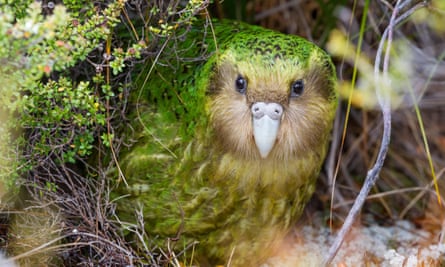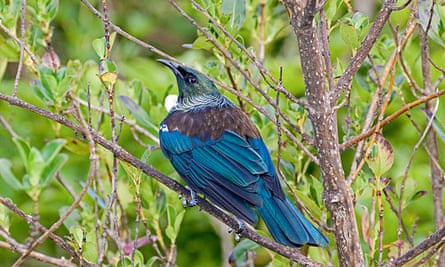When unsuspecting Miami zoo ambassador Ron Magill woke on Tuesday, he could not have anticipated the storm of fury he was about to encounter.
Opening his inbox, the wave broke: hundreds of furious tweets, emails, videos, trending hashtags, TikToks. A 13,000-signature petition, news stories leading every local media outlet, a formal government statement. As the day wore on, the furore attracted attention from New Zealand’s highest office – the prime minister weighed in at a press conference.
Those outside Aotearoa may have been surprised to learn the furore was tied to a single bird: Pāora the kiwi. New Zealanders had realised it was being handled by the public under bright lights – a treatment unsuitable for its reclusive, nocturnal nature. “We have offended a nation,” Magill declared, offering profuse apologies from the zoo and swiftly ending its Kiwi Encounter programme.
The Pāora incident will go down as just one of the recent examples of New Zealand’s ferocious love of its birds. “Hell hath no fury like the citizens of a country who hold a ‘bird of the year’ contest,” quipped Auckland scientist Catherine Qualtrough – and the country does have an internationally unusual focus and dedication to its winged creatures. That love has shaped its national identity and conservation agenda and launched an enormous country-wide campaign to wipe out animals that threaten the avian population.
“You know what you know,” says Andrew Digby, a science adviser at the Department of Conservation – and what New Zealand knows is birds. The country is one of only a handful of places around the world that have no native terrestrial mammals.
The islands that now make up New Zealand began breaking away from other land masses about 80 million years ago, when dinosaurs were still living, and before mammals had evolved to become widespread. As a result, the country’s only endemic mammal species are bats and marine creatures like seals. By 60m years ago, Aotearoa was completely isolated from other land bodies, and its bird population was developing to fill the evolutionary niches typically filled by mammals.
As a result of that extraordinary ecological history, many of New Zealand’s birds are highly unusual, with distinctive traits and uncommon size. The kererū, an enormous wood pigeon, is known to grow drunk eating fermented berries and fall from trees – sometimes inundating bird sanctuaries with intoxicated birds needing to sober up. A large portion are flightless ground-dwellers, adapted to avoid airborne raptors as their predators, rather than furry beasts. Best known is the kiwi – shy and flightless, with the proportions of a bowling ball – which is enough of a national icon that “kiwis” has become common vernacular for New Zealanders.
But there are other icons: the now-extinct giant moa, standing up to 3.6m (12ft) and weighing about 230kg, was a wingless, grazing herbivore. Kea, the mischievous, kleptomaniac alpine dwellers that attack windscreen wipers, steal cameras and have learned to use tools. Kākāpō, the world’s fattest parrots, are nocturnal, flightless and hefty, with a distinctive waddling gait. Kākāpō behave more like a badger than a bird, says Digby: “a herbivorous, tree-climbing badger, filling that niche – they live in holes in the ground, come out at night, that’s a real mammalian trait”.
Māori culture regards a number of those species as taonga – cultural treasures that must be honoured and protected. And across the country, they are viewed with a fierce affection and pride.
“One thing they don’t tell you is that New Zealanders absolutely love talking about their birds,” remarked comedian Rebecca Shaw when she migrated. “Every time I’ve been at a gathering of three or more people, they have started talking about the birds at some point.” The country holds a national bird of the year election each year, with strict voting rules, and campaign teams for different candidates.

“It’s a massive part of our identity, right?” says Damian Christie, a New Zealand broadcaster who now runs a neighbourhood trapping group. “The birds were here before any of us. The birds are such a part of our folklore, of Māori mythology – and then there’s that call. You can’t ignore that call in the morning.”
For millions of New Zealanders, the day begins with the birds: either outside the window or over the radio, where every morning the national broadcaster heralds its AM news bulletins with a native birdcall. Suggestions that “the bird” might be axed by the state network in 2005 were quickly ditched after uproar from listeners – the radio said it received 1,600 emails by lunchtime, and a woman unfurled a “Keep the Bird” banner from her apartment window opposite the station’s headquarters. For others, it’s the actual dawn chorus – one that’s growing louder after concerted efforts to establish predator-free urban sanctuaries and eliminate threats to native birdlife.
As well as the unusual nature of the birds themselves, they’re often shot to prominence by the country’s unusual, sometimes experimental approach to preserving their welfare. Nigel, dubbed “the lonely gannet”, made international headlines after news spread that he had spent years dedicatedly attempting to seduce concrete replica gannets on an isolated island off the New Zealand coast. The concrete birds had been installed by conservation officers, who hoped they would successfully attract and establish a gannet colony.
A far more widespread strategy, however, is New Zealand’s enormous effort to wipe out – or at least dramatically reduce – introduced mammals like rats, possums, stoats and hedgehogs, which pose a significant threat to native species, and to set up predator-free sanctuaries – islands or fenced-off sections of the mainland – where birds can live unaccosted.

Christie is one of many New Zealanders who now facilitates backyard trapping in his neighbourhood, supplying traps for about 100 households to catch and kill rats, stoats or other mammals that kill birds and eat their eggs. “For me, it was all about the bird life,” he says. “It’s about doing what you need to do to get those birds to come back to the city.”
The scope, scale and ambition of New Zealand’s conservation efforts are “quite unusual”, Digby says. “There’s lot of work for the size of the country … a lot of a lot of frontline cutting edge work goes on in conservation in New Zealand – it pushes the boundaries a bit because it’s got such an unusual set of circumstances.”
In some places, it’s working. In the capital city of Wellington, kiwi have been re-released into the hills, after mammoth efforts to clear them of predators. Once-rare native species like tūī and kākā are being seen flying through the city again, after establishing populations at an inner-city bird sanctuary.
“You’ll get kākā flying across the CBD, and people notice those things – even people who don’t know conservation,” Digby says. “It’s visible to everybody.”

